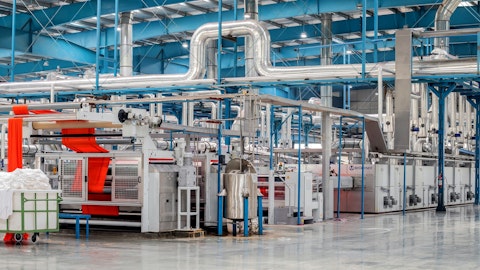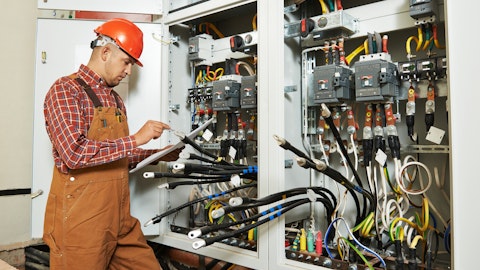Donovan Schafer: I’d like to take a moment and just ask something a bit kind of maybe a higher level or not as maybe a near term quarter to quarter issue. But in the last couple of years with how much — it kind of feels like the home standby market itself has changed just with how much growth there’s been with the COVID demand and everything. I’m wondering if you can give us an update on kind of the competitive landscape there. Of course, rising tide lifts all boats, so everyone can be doing well. But for a long time, you’ve talked about having the 75% market share. I’m curious if you still — if your sense is still that, that’s kind of where you are today, about 75% market share with home standby or if there are there any changes there, is that is incrementally moving higher or lower even while everything rises?
Or if you don’t have that in particular, are you seeing competitors make any move saying, hey, this is getting to be a really big market, you purchase and own your own copper winding equipment because of the scale that you have, but if the whole market is growing, are you aware of like competitors making moves like that, buying their own copper lining equipment? Anything like that kind of just higher level update on the competitive dynamics in the home standby market.
Aaron Jagdfeld: Yes, it’s a great question, Donovan. I mean we don’t talk too much about that. And we probably — it’s a good checkpoint. I would tell you that we believe our share is probably north of that 75%. We’ve probably grown over the last few years, a little bit probably more outsized. You’re right though that a rising tide raises all boats there. And I think our competitors are — first of all, the competitive set is the same and it’s been the same for almost 20 years in the category, which is interesting to me. And the two other competitors that play in that space, it’s a much smaller part of their business, right? Like their businesses, their core businesses or other things. So for those competitors, the power — the home standby generators in particular are a tertiary or even further down the pole kind of product line for them.
So in terms of their focus, right, just raw focus on the products, the development, we still are the only product in the market that has connectivity out of the box, right? So that we give homeowners, every homeowner who buys a home standby today can get updates on the status of their generator through Mobile Link, which is our app or now they can get through the ecobee platform, which is awesome. We just rolled that out as part of our ecosystem. Those types of things, our competitors don’t have that, and that’s I think one of the beautiful things about scale. And you pointed out that the advantages of that on the manufacturing side, right, our ability to invest heavily in the machine tooling and the capabilities we need to continue to drive the kind of — not only the capacity that we need right to grow the market, which is where we struggled over the last few years until recently is getting capacity to increase at the rate of the increase in the market, but also the scale extends beyond just manufacturing, right?
Our ability to invest in driving sales leads. I mean we are spending tens of millions of dollars advertising to drive sales leads. The platform, PowerPlay, which is our sales — selling platform, that’s a unique platform in the marketplace. Our ability to recruit distribution, right, and to put the kind of focus on that effort. Again, if you’re a smaller player in this market and for somebody that — if you’re mid single digit kind of market share or 10% share, and it’s a small part of your business, too, you have to think about the context of making a business decision about investing to that level. Even though it’s a good market, I think that’s a difficult decision to make if you’re some of our competitors. So we’re trying to use our scale to continue to grow and to continue to do, I think, things that lead the industry.
We’ve done that for two decades or more, and we’re going to continue to do that in terms of leaning in to things like connectivity, things like the next generation home standby generator, which we haven’t talked much about, but we’ve got some really exciting product developments there that we’ll talk about as the year progresses here. But that’s the kind of thing that I think once we get — once you unpack that, you look at what scale gets you, it’s just one of those things where we’ve got that flywheel spinning very, very fast right now, and we continue to invest heavily in it.
Operator: And our next question comes from Maheep Mandloi from Credit Suisse.
Maheep Mandloi: Firstly, I just want to check if — do you assume any price reductions for the home standby generators in the guidance? And second question on the online channels versus your dealer and distributors. Could you just talk about that dynamic, what the share is and if you’re seeing a growth in online versus dealers, and how is that impacting the relationship with your traditional channels?
Aaron Jagdfeld: So I think I’ll deal with it. From a share perspective, we don’t break down the channel share. But our dealer channel is our biggest channel, it’s a really important channel. Obviously, they do — obviously, the lion’s share of installations in the network that’s not restricted just to dealers. I mean, if you’re an electrical contractor, you can do installations as well and you have access to the product through an electrical wholesale channel, if you want to buy, but maybe you don’t want to commit to the level that you need to commit to, to be a dealer, right, to carry inventory, to supply service and to do the work there to be a dealer. It’s a different level. Our e-commerce partners are also an important channel, though, and have been for some time.
It’s a great way for homeowners who — if they find they want to project manage this on their own, right, hire their own electrical contractor or plumber to do the work, there might be a way for them to save a few dollars that way, but it’s a little more work, right? A dealer provides a turnkey solution for most homeowners. And what we’re finding is as the category matures, dealer share has grown faster than other channel share, because more people who get into the category really want a turnkey solution. So dealers will pull the permit, they’ll do all the work that’s needed to make that a seamless project for the homeowner. As far as pricing, your question on pricing, really, all we’ve built into the guide this year, and I think we’ve called this out, that’s a higher level of promotion, as you would expect, as the category starts to normalize in terms to get to that new and higher level, baseline level.
We would expect a higher level of promotion. There’s been very little in the way of promotion over the last several years. So when you think about price on a net basis, I would say there’s some of that net price built in, there’s probably less price this year, a lower price this year on a net basis than prior year simply because of increased discounts.
York Ragen: Now that we’ve caught the backlog when you’re in a position of backlog, you don’t promote as much. But there’s a normal cadence of promotion every year when you’re not in backlog, and we’ll revert back to that.
Operator: And our next question comes from Kashy Harrison from Piper Sandler.
Kashy Harrison: So core sales in the C&I business in Q4 was about 27%, it sounds like, and I think maybe 30% for the full year. You’re indicating you have a record backlog and you’re seeing strength across all segments. And so I was wondering if you could maybe speak to the durability of demand in C&I over a multiyear time period? And then maybe just provide some color as to why C&I revs are only up in the mid to high single digits just given what you saw in Q4 and in 2022?
Aaron Jagdfeld: The C&I business, we said in the prepared remarks, but it continues to outperform our expectations. They had a fantastic Q4. And so the durability of the demand, that is a lead time business, right, I think we’ve talked about this in the past. Our residential business, in particular, the home standby business has not traditionally been a backlog business or a lead time business, even though it got to that position through the outsized demand that was happening over the last several years. But C&I has always been kind of a business, you look at book-to-bill, and we see record levels of backlog in that business as we exit 2022. And that’s both domestically as well as internationally. And so that gives us confidence and, frankly, really good visibility into the year here.
I would say that within the C&I business, there’s a couple of big pieces of that, though, that where maybe visibility is less so and maybe kind of leads to why we’re saying mid to high single-digit growth for the year. The growth cycles for telecom and for our mobile equipment, which are generally sold through the larger national rental account customers can be a bit lumpy from time to time. They can turn the CapEx spending on and off quite quickly. And so we have some visibility based on forecasts, you can listen to — as we do when we dialog with our national rental account customers, we listen to their guides on CapEx spending for the upcoming year. And they’re all, by enlarge, kind of forecasting similar levels to last year, if not greater levels based on the company.
And our telecom customers are also telling us they’re continuing to build out their networks, harden their networks, they’re focused on building out 5G. But look, we’ve been down this road before and we’re also — we’re cognizant of the fact that things can happen and they can turn the CapEx spending off quickly. So I think we’re positioning a bit to say we have less visibility around telecom and national rental accounts versus some of our distributor business, both kind of internationally and domestically here, where we have very good backlog and very good visibility, and put all that together and we also have some tougher comps in the second half of the year. Q4 was really, really heavy. And so kind of coming up against that tougher comp in the second half of the year, we’re just — that kind of manifests itself, I think, in a lower growth rate.
So I think you put all that together, I think kind of mid to high single digit growth still feels kind of appropriate right now at this kind of stage of the cycle, but we’re watching it.
Operator: Our next question comes from Praneeth Satish from Wells Fargo.
Praneeth Satish: I wanted to go back to HSB and the guidance for the large increase in the second half. I guess I’m just wondering how much improvement in installation capacity would you need to see over the course of the year to achieve that growth? And could you get there based on the current pace of installation capacity growth over the last few quarters, or would you need to kind of see a more pronounced growth in installation capacity to support your revenue guidance for the second half?
Aaron Jagdfeld: So it’s a great question and fundamental, obviously, to how we think about the ability to hit these targets in the second half. We do need installation bandwidth to continue to expand and grow. Now we grew very nicely last year and ended the year very strong in Q4. You’ve got normal seasonality that happens there. You get into the winter months here, the depths of the winter months. And as we would expect activations are down versus fourth quarter, because that’s kind of pacing we normally see, right? It’s really hard to install product when there’s a foot of snow on the ground or there’s still frost in the ground in the Northeast, the Midwest, in other areas of the country like that. But to answer your question directly, we do have built into the model that there has to be an increase yet in installation bandwidth.
Now we added 500 new dealers in the back half of the year, that’s going to help a lot and we’re going to continue to add dealers and focus on expanding distribution here throughout 2023 to pace towards that higher activation rate that we’re going to need by the time we exit 2023. But I will say this, it’s not the kind of increase like looking back, it’s not the kind of increase we would have needed at this point last year. If we had probably been kind of — I think we’re more optimistic that the channel was going to respond favorably to our increase in capacity output at the factory, we felt that they were going to increase their installation capacity at the same — commensurate with that pace. And if you kind of stood back and looked at that, today, it’s like, wow, okay, that’s really large.
The question you’re asking, that’s a really large increase last year. This year, it’s not nearly the size increase year-over-year, because we’ve made really good progress. And in Q4, we made really good progress as well on increasing activation. So it’s a smaller kind of hill to climb than if you compare it to the prior year, it was a much bigger hill to climb. And again, looking back on that and now kind of fully understanding the challenges that distribution had in adding the labor they needed and doing all the things that they needed to do to respond on a commensurate basis with our capacity increases, that was really the fundamental problem we ran into in kind of running well past them in terms of shipments. So that I think we feel better about where we’re at today as we think about that hill we have to climb, but there is still an increase needed as we exit 2023.
Operator: And our next question comes from George Gianarikas from Canaccord Genuity.





